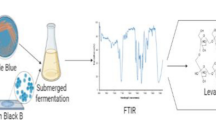Abstract
Nineteen Propionibacterium strains were screened for extracellular polymer (ECP) production. The best producer, P. jensenii S1, was introduced into two different media, Yeast Extract Lactate (YEL)-medium and Apricot Effluent (AE)-medium. The YEL medium samples were incubated in different mixing systems (a roller-table and a linear shaking platform) for 24 days at 35 °C. According to the volatile fatty acids and pH profiles, no real differences could be detected between the two mixing systems. Bacterial aggregates were, however, only observed in the roller-table samples. The process was repeated with AE-medium on the roller-table. Larger and more stable flocs were observed in the AE-medium samples. Scanning electron microscopy and PCR analysis confirmed the presence of propionibacteria in these flocs even after 5 months of storage at 4 °C. It was concluded that ECP-producing Propionibacterium strains could be manipulated to form bacterial flocs under certain environmental conditions, which might be enhanced in the presence of fibrous material occurring naturally in food industry effluents.
Similar content being viewed by others
References
Batstone, D.J. & Keller, J. 2001 Variation of bulk properties of anaerobic granules with wastewater type. Water Research 35, 1723–1729.
Bossier, P. & Verstraete, W. 1996 Triggers for microbial aggregation in activated sludge. Applied Microbiology and Biotechnology 45, 1–6.
Britz, T.J., Van Schalkwyk, C. & Roos, P. 2002 Development of a method to enhance granulation in a laboratory batch system. Water SA 28, 1–6.
Cato, E.P., Cummins, C.S. & Smith, L.D.S. 1970 Clostridium limosum André ubin Prèvot1948, 165. Amended description and pathogenic characteristics. International Journal of Systematic Bacteriology 20, 305–316.
Cerning, J. 1990 Exocellular polysaccharides produced by lactic acid bacteria. FEMS Microbiology Reviews 87, 113–130.
Greenberg, A.E., Clesceri, L.S. & Eaton, A.D. 1992 Standard Methods for the Examination of Water and Wastewater. 18th edn. Washington DC, USA: American Public Health Association, ISBN 0-875-53207-1.
Lettinga, G., Hulshoff Pol, L.W., Zeeman, G., Field, J., Van Lier, J.B., Van Buuren, J.C.L., Janssen, A.J.H. & Lens, P.N.L. 1997 Anaerobic treatment in sustainable environmental production concepts. In Anaerobic Digestion VIII: Proceedings of the 8th IAWQ International Conference on Anaerobic Digestion (vol. 1) held 25-29 May in Sendai, Japan. pp. 32–39. Japan: Ministry of Education.
Ludbrook, K.A., Russell, C.M. & Greig, R.I. 1997 Exopolysaccharide production from lactic acid bacteria isolated from fermented foods. Journal of Food Science 662, 597–600.
Qatibi, A.I., Bories, A. & Garcia, J.L. 1990 Effects of sulfate on lactate and C2-, C3-volatile fatty acid anaerobic degradation by a mixed microbial culture. Antonie van Leeuwenhoek 58, 241–248.
Racine, M., Dumont, J., Champagne, C.P. & Mortin, A. 1991 Production and characterization of the polysaccharide from Propionibacterium acidipropionici on whey-based medium. Journal of Applied Bacteriology 71, 233–238.
Riedel, K-H.J. & Britz, T.J. 1993 Propionibacterium species diversity in anaerobic digesters. Biodiversity and Conservation 2, 400–411.
Riedel, K-H.J., Wingfield, B. & Britz, T.J. 1998 Identification of classical Propionibacterium species using 16S rDNA-restriction fragment length polymorphisms. Journal of Systematic and Applied Microbiology 21, 419–428.
Schmidt, J.E. & Ahring B.K. 1993 Granular sludge formation in upflow anaerobic sludge blanket (UASB) reactors. Biotechnology and Bioengineering 49, 229–246.
Schoeman, T. 2001 The characterization and identification of the active microbial consortium of kepi grains. MSc thesis, University of Stellenbosch, Stellenbosch, South Africa.
Van Elsas, J.D., Mantynen, V. & Wolters, A. 1997 Soil DNA extraction and assessment of the fate of Mycobacterium chlorophenolicum strain PCR-1 in different soils by 16S ribosomal RNA gene sequence based most-probable-number PCR and immuno-fluorescence. Biological Fertilization 24, 188–195.
Vorobjeva, L.I. 1999 Propionibacteria. The Netherlands: Kluwer Academic Publishers. ISBN 0-792-35884-8.
Author information
Authors and Affiliations
Rights and permissions
About this article
Cite this article
van Schalkwyk, C., Joubert, H. & Britz, T. Extracellular polymer production and potential for aggregate formation by classical propionibacteria. World Journal of Microbiology and Biotechnology 19, 285–289 (2003). https://doi.org/10.1023/A:1023606308920
Issue Date:
DOI: https://doi.org/10.1023/A:1023606308920




